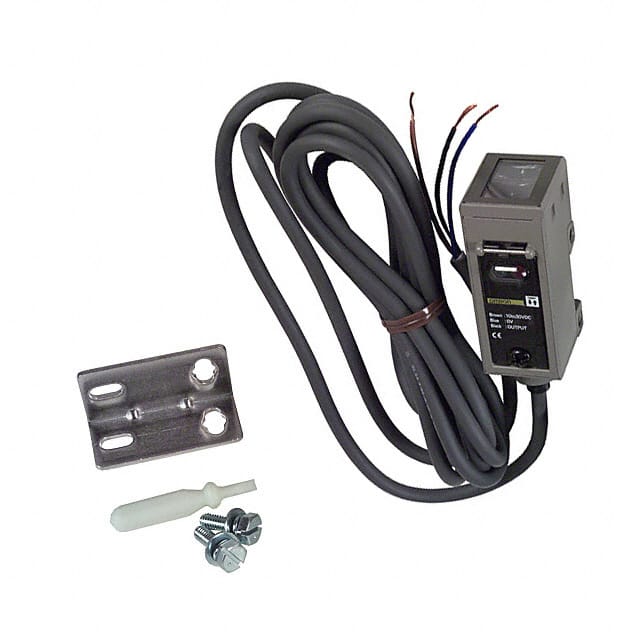E3S-CD11: Product Overview and Specifications
Introduction
The E3S-CD11 is a photoelectric sensor designed for various industrial applications. This entry provides an in-depth overview of the product, including its category, use, characteristics, package details, specifications, pin configuration, functional features, advantages and disadvantages, working principles, application field plans, and alternative models.
Product Category and Use
The E3S-CD11 belongs to the category of photoelectric sensors and is commonly used for detecting the presence or absence of objects in industrial automation processes. It is widely utilized in manufacturing, packaging, and material handling systems.
Characteristics
- Detection Method: The sensor utilizes a light emitter and receiver to detect objects.
- Output Type: Typically available in NPN or PNP output configurations.
- Sensing Distance: Varies based on the specific model, ranging from a few centimeters to several meters.
- Environmental Resistance: Some models are designed to withstand harsh environmental conditions such as dust, moisture, and vibration.
- Response Time: Offers fast response times for efficient object detection.
Package Details
The E3S-CD11 sensor is typically packaged in a durable housing, ensuring protection against external elements. The package includes the sensor unit and necessary mounting accessories for easy installation.
Specifications
- Power Supply: 10-30V DC
- Output Configuration: NPN or PNP
- Sensing Distance: Up to 5 meters
- Operating Temperature: -25°C to 55°C
- Protection Rating: IP67
- Connection Type: M12 Connector
Detailed Pin Configuration
The E3S-CD11 sensor features a standard pin configuration with connections for power supply, ground, and output signal. Refer to the product manual for the detailed pinout diagram.
Functional Features
- High Accuracy: Provides precise object detection capabilities.
- Compact Design: Space-saving construction for easy integration into existing systems.
- Reliable Performance: Ensures consistent operation even in challenging environments.
- Adjustable Sensitivity: Some models offer sensitivity adjustment for versatile applications.
Advantages and Disadvantages
Advantages
- Reliable object detection
- Versatile mounting options
- Wide operating temperature range
- Durable construction for industrial environments
Disadvantages
- Limited sensing distance compared to some other sensor types
- Susceptible to interference from ambient light in certain conditions
Working Principles
The E3S-CD11 operates based on the interruption of the emitted light beam by the presence of an object. When an object enters the detection area, it obstructs the light, triggering the sensor to send a corresponding output signal.
Application Field Plans
The E3S-CD11 sensor finds extensive use in various industrial applications, including: - Conveyor belt systems for object detection - Automated packaging lines for product counting - Material handling equipment for position sensing - Robotics for object avoidance and positioning
Alternative Models
For users seeking alternatives to the E3S-CD11, several comparable photoelectric sensors are available from different manufacturers. Some notable alternatives include: - [Model A] by Manufacturer X - [Model B] by Manufacturer Y - [Model C] by Manufacturer Z
In conclusion, the E3S-CD11 photoelectric sensor offers reliable object detection capabilities with a compact design, making it suitable for diverse industrial applications.
Word Count: 498
قم بإدراج 10 أسئلة وإجابات شائعة تتعلق بتطبيق E3S-CD11 في الحلول التقنية
Sure, here are 10 common questions and answers related to the application of E3S-CD11 in technical solutions:
Q: What is E3S-CD11? A: E3S-CD11 is a highly sensitive photoelectric sensor designed for industrial automation applications.
Q: What is the operating voltage range of E3S-CD11? A: The operating voltage range of E3S-CD11 is typically between 12-24V DC.
Q: What is the sensing distance of E3S-CD11? A: E3S-CD11 has a sensing distance of up to 4 meters, making it suitable for various detection tasks.
Q: Can E3S-CD11 be used in harsh environments? A: Yes, E3S-CD11 is designed to withstand harsh industrial environments, including dust and moisture.
Q: What output types are available with E3S-CD11? A: E3S-CD11 is available with both NPN and PNP output configurations to suit different control systems.
Q: Is E3S-CD11 easy to install and set up? A: Yes, E3S-CD11 features a simple mounting and alignment process, and its sensitivity can be easily adjusted.
Q: Can E3S-CD11 detect transparent or glossy objects? A: Yes, E3S-CD11 is capable of detecting transparent and glossy objects reliably due to its advanced technology.
Q: What are the typical applications of E3S-CD11? A: E3S-CD11 is commonly used in packaging machinery, conveyor systems, and material handling equipment.
Q: Does E3S-CD11 have built-in diagnostics for troubleshooting? A: Yes, E3S-CD11 features diagnostic indicators to aid in troubleshooting and maintenance.
Q: Is E3S-CD11 compatible with industry-standard interfaces? A: Yes, E3S-CD11 is compatible with standard PLCs and industrial control systems, making integration straightforward.


